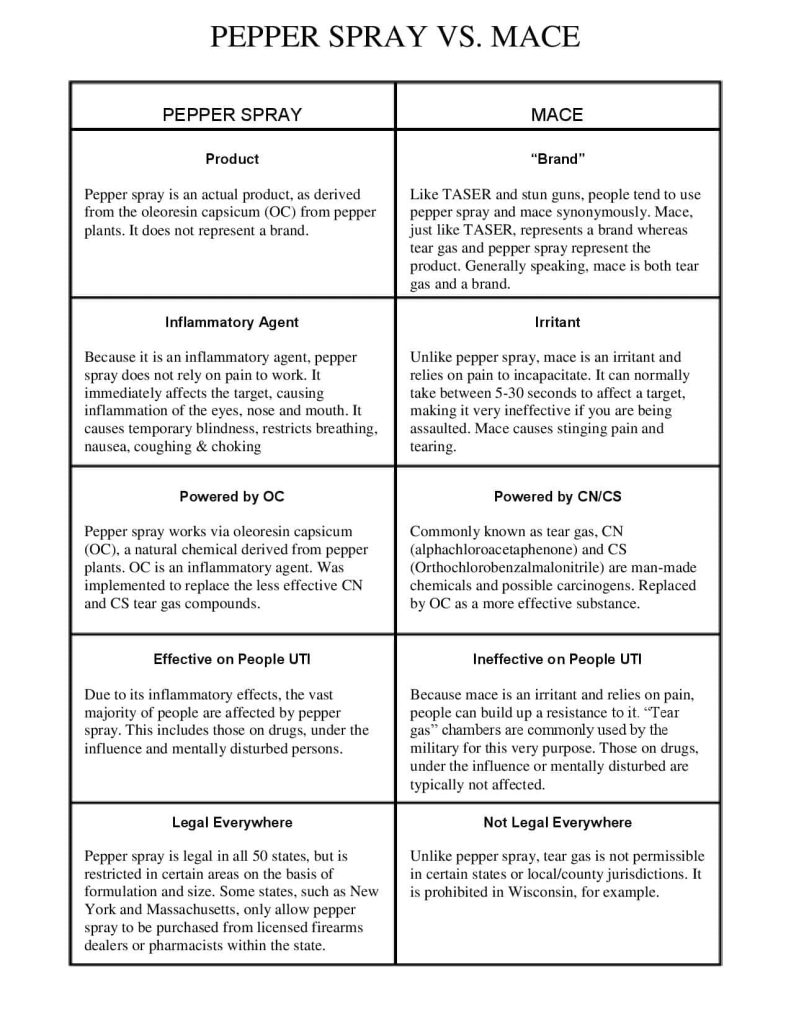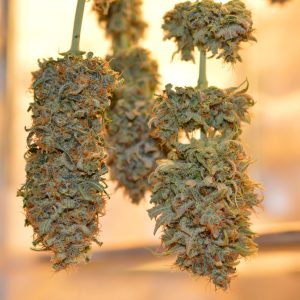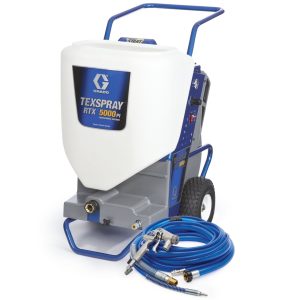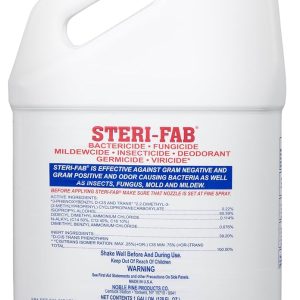
When it comes to personal safety and self-defense, understanding the differences between pepper spray vs mace is crucial for making an informed decision. Many people use these terms interchangeably, but they represent distinct self-defense tools with different active ingredients, effectiveness levels, and legal considerations. This comprehensive analysis will help you understand which option provides better protection for your specific needs.
What is Pepper Spray? Understanding OC-Based Self-Defense
Pepper spray is a non-lethal self-defense weapon that contains oleoresin capsicum (OC) as its active ingredient. Derived from hot peppers, particularly cayenne peppers, this inflammatory agent creates an immediate and intense burning sensation upon contact with skin, eyes, or respiratory system. The effectiveness of pepper spray is measured in Scoville Heat Units (SHU), with most commercial pepper sprays ranging from 2 million to 5.3 million SHU.
The mechanism of action for pepper spray involves causing immediate inflammation of mucous membranes, leading to temporary blindness, difficulty breathing, and intense burning pain. Unlike other self-defense sprays, pepper spray works on both humans and animals, making it particularly effective against aggressive dogs or wildlife encounters. The effects typically last between 15 to 45 minutes, providing sufficient time for the victim to escape and seek help.
Modern pepper spray formulations come in various concentrations, with law enforcement grade typically containing 10-18% OC concentration. Consumer-grade pepper sprays usually contain 1-5% OC, which is still highly effective for personal protection. The spray pattern can vary from a narrow stream for accuracy to a wide fog pattern for maximum coverage, depending on the specific product design and intended use case.
What is Mace? The CN and CS Chemical Difference
Mace is a brand name that has become synonymous with self-defense sprays, but traditional mace contains different active ingredients than pepper spray. Original mace formulations used chloroacetophenone (CN) as the primary active ingredient, while modern versions often contain chlorobenzalmalononitrile (CS), commonly known as tear gas. These chemical compounds work differently than the natural capsaicin found in pepper spray.
The effects of mace are primarily focused on irritating the eyes and respiratory system, causing tearing, coughing, and temporary disorientation. Unlike pepper spray, which causes inflammation, mace works through chemical irritation that can be less effective on individuals under the influence of drugs or alcohol. The onset of effects may be slower compared to pepper spray, and the duration is typically shorter, lasting approximately 5-10 minutes.
Traditional mace formulations have been largely replaced by pepper spray-based products, even under the Mace brand name. Many modern “mace” products actually contain OC (pepper spray) rather than CN or CS chemicals. This shift occurred due to the superior effectiveness and safety profile of oleoresin capsicum compared to traditional chemical irritants.
Pepper Spray vs Mace: Effectiveness Comparison
When comparing pepper spray vs mace in terms of effectiveness, several factors must be considered including stopping power, reliability, and duration of effects. Pepper spray consistently outperforms traditional mace in independent testing and real-world scenarios. The inflammatory response caused by capsaicin is involuntary and affects all individuals regardless of pain tolerance, mental state, or substance use.
| Factor | Pepper Spray | Traditional Mace |
|---|---|---|
| Effectiveness Rate | 85-95% | 60-75% |
| Onset Time | Immediate | 5-30 seconds |
| Duration | 15-45 minutes | 5-10 minutes |
| Works on Intoxicated Individuals | Yes | Limited |
| Animal Effectiveness | Highly effective | Moderately effective |
Research conducted by the National Institute of Justice found that pepper spray was effective in 85% of cases involving human attackers, while traditional mace showed effectiveness rates of approximately 65%. The superior performance of pepper spray is attributed to its ability to cause immediate physical incapacitation rather than relying solely on pain compliance.
The range and accuracy of deployment also favor pepper spray in most scenarios. Quality pepper spray products can effectively reach targets at distances of 8-12 feet, while maintaining accuracy and concentration. Traditional mace often has shorter effective ranges and may dissipate more quickly in outdoor environments with wind or air movement.
Legal Considerations: Pepper Spray vs Mace Regulations
Understanding the legal landscape surrounding pepper spray vs mace is essential for responsible ownership and use. Federal regulations in the United States generally permit both pepper spray and mace for civilian use, but state and local laws vary significantly. Some jurisdictions have specific restrictions on concentration levels, container sizes, and purchase requirements.
New York State, for example, has specific regulations regarding pepper spray ownership and use. Residents interested in pepper spray New York regulations should understand that the state requires pepper spray to be purchased from licensed dealers and prohibits online sales to New York residents. The state also limits the size of pepper spray containers and requires specific labeling.
Several states have banned or restricted CN-based mace products due to safety concerns, while maintaining more permissive regulations for pepper spray. California, Massachusetts, and Wisconsin have specific restrictions on mace containing CN, but generally allow pepper spray with certain limitations. International travel with either product requires careful research of destination country laws, as many nations prohibit or strictly regulate these self-defense tools.
Age restrictions also apply in many jurisdictions, with most states requiring purchasers to be at least 18 years old. Some states require safety training or certification before purchase, while others have specific storage requirements for households with minors. Law enforcement and military personnel often have exemptions from civilian restrictions and may carry more potent formulations.
Active Ingredients: Chemical Composition Analysis
The fundamental difference in pepper spray vs mace lies in their active ingredients and how these compounds interact with human physiology. Pepper spray contains oleoresin capsicum (OC), a natural extract from hot peppers that binds to pain receptors and causes immediate inflammation. This biological response cannot be overcome through willpower or tolerance, making it universally effective.
Traditional mace contains synthetic chemicals such as chloroacetophenone (CN) or chlorobenzalmalononitrile (CS). These compounds work by irritating mucous membranes and causing chemical burns to exposed tissue. The effectiveness of these chemicals can be reduced by factors such as alcohol consumption, drug use, or high adrenaline levels that may occur during violent encounters.
The concentration and formulation of active ingredients significantly impact effectiveness. Pepper spray concentrations are measured in both percentage of OC and Scoville Heat Units (SHU). A higher percentage doesn’t necessarily mean more effective, as the quality and potency of the oleoresin capsicum matter more than pure concentration. Most effective civilian pepper sprays contain 1-4% OC with 2-3 million SHU ratings.
Mace formulations typically contain 0.35-1% CN or CS, with effectiveness measured by the speed of onset and duration of effects. These lower concentrations are designed to minimize permanent damage while still providing stopping power. However, the synthetic nature of these chemicals means they may have inconsistent effects across different individuals and situations.
Range and Accuracy: Deployment Effectiveness
The practical application of pepper spray vs mace involves understanding their deployment characteristics, including range, accuracy, and environmental factors. Pepper spray typically offers superior range and accuracy compared to traditional mace products. Quality pepper spray units can effectively engage targets at distances of 8-15 feet, depending on the specific formulation and delivery system.
Stream patterns provide maximum accuracy and are ideal for situations requiring precise targeting. The concentrated stream minimizes cross-contamination and reduces the risk of affecting the user or bystanders. Fog patterns offer wider coverage but sacrifice range and accuracy, making them better suited for close-quarters encounters or situations involving multiple attackers.
Wind conditions significantly affect both pepper spray and mace deployment. Pepper spray’s thicker consistency and higher viscosity make it less susceptible to wind drift compared to traditional mace. However, users must still consider wind direction and speed when deploying any aerosol self-defense product. Indoor use requires careful consideration of ventilation and potential contamination of the immediate area.
Mace products typically have shorter effective ranges due to their lighter chemical composition and tendency to dissipate more quickly. The effective range for most mace products is 6-10 feet, with accuracy declining rapidly beyond this distance. The chemical nature of mace also makes it more susceptible to environmental factors such as humidity and temperature variations.
Safety and Health Considerations
Understanding the safety profiles of pepper spray vs mace is crucial for responsible use and storage. Pepper spray is generally considered safer for both users and targets due to its natural origin and well-documented effects. The capsaicin in pepper spray causes temporary inflammation without permanent damage when used properly. Medical complications are rare and typically limited to individuals with severe respiratory conditions.
Traditional mace containing CN or CS chemicals carries higher health risks, particularly for individuals with asthma, heart conditions, or other respiratory issues. The synthetic chemicals in mace can cause more severe reactions and may lead to complications in sensitive individuals. Long-term exposure or excessive concentration can result in chemical burns or respiratory damage.
Proper storage and handling are essential for both products. Pepper spray should be stored in cool, dry conditions away from direct sunlight and extreme temperatures. The pressurized containers can leak or malfunction if damaged, and expired products may have reduced effectiveness. Most pepper spray products have a shelf life of 2-4 years when stored properly.
Training and practice are recommended for both pepper spray and mace users. Understanding proper deployment techniques, safety distances, and post-use procedures can prevent accidents and ensure effectiveness during actual encounters. Many law enforcement agencies and self-defense instructors offer training programs for civilian users.
Cost and Availability Analysis
The economic factors of pepper spray vs mace include purchase price, availability, and long-term costs. Pepper spray is generally more affordable and widely available than traditional mace products. Basic pepper spray units can be purchased for $10-20, while professional-grade units may cost $30-50. The widespread availability of pepper spray makes it accessible to most consumers.
Traditional mace products are typically more expensive due to their specialized chemical composition and limited production. Prices for quality mace products range from $20-60, depending on size and concentration. The reduced availability of traditional mace products may also increase costs in some markets.
Replacement and maintenance costs should be considered when choosing between these options. Both products require periodic replacement due to expiration dates and potential leakage. Pepper spray typically has longer shelf life and more predictable replacement schedules compared to chemical mace products.
Bulk purchasing options are available for both products, with pepper spray showing better economies of scale. Organizations, businesses, and families may benefit from purchasing multiple units, particularly for pepper spray products that offer consistent quality and effectiveness.
Professional and Law Enforcement Preferences
The preferences of law enforcement and security professionals provide valuable insight into the pepper spray vs mace debate. Most police departments and security agencies have transitioned to pepper spray-based systems due to their superior effectiveness and reduced liability concerns. The consistent performance and lower risk of permanent injury make pepper spray the preferred choice for professional applications.
Military and tactical units often use specialized pepper spray formulations with higher concentrations and enhanced delivery systems. These professional-grade products are not typically available to civilians but demonstrate the confidence that trained professionals place in pepper spray technology. The natural origin of capsaicin also reduces concerns about chemical weapon treaties and international law.
Security industry standards have evolved to favor pepper spray over traditional mace products. Professional security training programs emphasize pepper spray use due to its reliability and effectiveness across diverse situations. The reduced training requirements and lower legal liability make pepper spray more practical for security personnel.
Prison and correctional systems have extensively tested both products and consistently choose pepper spray for inmate control and officer safety. The immediate effectiveness and temporary nature of pepper spray effects make it ideal for controlled environments where de-escalation and safety are paramount.
Environmental and Storage Factors
The environmental stability and storage requirements of pepper spray vs mace significantly impact their practical utility. Pepper spray demonstrates superior environmental stability across various temperature ranges and humidity conditions. The natural oleoresin capsicum remains effective in extreme heat and cold, making it suitable for diverse climates and storage conditions.
Traditional mace products are more sensitive to environmental factors, particularly temperature fluctuations and humidity. The chemical compounds in mace can degrade more rapidly when exposed to extreme conditions, reducing their effectiveness over time. Proper storage becomes more critical for maintaining mace effectiveness compared to pepper spray.
Shelf life considerations favor pepper spray in most applications. Quality pepper spray products maintain their effectiveness for 2-4 years when stored properly, while traditional mace products may have shorter effective periods. The natural preservation properties of capsaicin contribute to the extended shelf life of pepper spray products.
Transportation and mobility factors also influence the choice between these products. Pepper spray is generally more stable during transport and less likely to leak or malfunction due to movement or vibration. The robust construction of most pepper spray containers makes them suitable for everyday carry and outdoor activities.
Real-World Performance Data
Statistical analysis of pepper spray vs mace effectiveness in real-world scenarios provides concrete evidence for decision-making. Crime prevention studies consistently show higher success rates for pepper spray compared to traditional mace products. The National Crime Victimization Survey data indicates that pepper spray is effective in stopping attacks in 85-90% of reported cases.
Case studies from law enforcement agencies demonstrate the practical advantages of pepper spray over mace. The Seattle Police Department reported a 95% effectiveness rate with pepper spray compared to 70% with traditional mace products before transitioning entirely to pepper spray systems. Similar results have been documented by agencies across the United States and internationally.
Animal control applications provide another data point for comparison. Pepper spray shows superior effectiveness against aggressive animals, including dogs, bears, and other wildlife. The natural capsaicin affects animal sensory systems more consistently than synthetic chemicals, making pepper spray the preferred choice for outdoor enthusiasts and animal control professionals.
User satisfaction surveys consistently rate pepper spray higher than traditional mace products. The factors contributing to higher satisfaction include ease of use, confidence in effectiveness, and reduced concern about collateral damage. Consumer reports indicate that 85% of pepper spray users would recommend it to others, compared to 60% for traditional mace products.
Technology and Innovation Trends
The evolution of pepper spray vs mace technology continues to favor pepper spray innovations. Modern pepper spray products incorporate advanced delivery systems, including gel formulations that reduce wind drift and foam versions that provide visual marking of targets. These innovations address traditional limitations while maintaining the core effectiveness of capsaicin.
Smart pepper spray devices with GPS tracking, automatic emergency alerts, and smartphone integration represent the cutting edge of self-defense technology. These connected devices provide additional safety features while maintaining the proven effectiveness of pepper spray. Traditional mace products have not seen similar technological advancement, largely due to the limitations of their chemical composition.
Combination products that integrate pepper spray with other self-defense tools are becoming increasingly popular. Pepper spray with UV marking dyes helps law enforcement identify attackers, while combination devices that include alarms or lights provide multiple layers of protection. These multi-functional products typically use pepper spray as the primary active ingredient.
Research and development efforts continue to focus on improving pepper spray formulations and delivery systems. Nano-encapsulation technology promises longer-lasting effects and improved accuracy, while bio-degradable formulations address environmental concerns. The investment in pepper spray innovation far exceeds that directed toward traditional mace products.
Making the Right Choice: Pepper Spray vs Mace
When deciding between pepper spray vs mace for personal protection, pepper spray emerges as the superior choice for most individuals and situations. The combination of higher effectiveness rates, better safety profile, wider availability, and lower cost makes pepper spray the practical choice for civilian self-defense needs.
Factors to consider when making your decision include legal restrictions in your area, intended use scenarios, storage requirements, and personal comfort level with different products. Pepper spray offers advantages in virtually every category when compared to traditional mace products, making it the recommended choice for most users.
Training and proper use remain essential regardless of which product you choose. Understanding deployment techniques, legal implications, and safety procedures ensures that your self-defense tool will be effective when needed. Regular practice and product replacement maintain the reliability of your chosen self-defense system.
Professional recommendations consistently favor pepper spray over traditional mace products. The evidence from law enforcement, security professionals, and civilian users supports the conclusion that pepper spray provides superior protection with fewer risks and complications.
Frequently Asked Questions About Pepper Spray vs Mace
Q: What is the main difference between pepper spray vs mace? A: The main difference is in active ingredients – pepper spray contains natural oleoresin capsicum (OC) from hot peppers, while traditional mace contains synthetic chemicals like CN or CS. Pepper spray is generally more effective and safer.
Q: Which is more effective, pepper spray vs mace? A: Pepper spray is more effective, with success rates of 85-95% compared to 60-75% for traditional mace. Pepper spray works on all individuals regardless of pain tolerance or substance use.
Q: Is pepper spray vs mace legal in all states? A: Both are legal in most states, but regulations vary. Some states have restrictions on concentration, size, or purchase requirements. Always check local laws before purchasing or carrying either product.
Q: How long do the effects last for pepper spray vs mace? A: Pepper spray effects typically last 15-45 minutes, while traditional mace effects last 5-10 minutes. Pepper spray provides longer-lasting protection and escape time.
Q: Which has better range, pepper spray vs mace? A: Pepper spray typically has better range (8-15 feet) compared to traditional mace (6-10 feet). Pepper spray also maintains accuracy better at longer distances.
Q: Can pepper spray vs mace be used on animals? A: Pepper spray is highly effective on animals and is specifically designed for wildlife protection. Traditional mace is less effective on animals and may not provide adequate protection.
Q: What are the health risks of pepper spray vs mace? A: Pepper spray is generally safer with fewer health risks due to its natural origin. Traditional mace contains synthetic chemicals that may cause more severe reactions, especially in sensitive individuals.
Q: How much does pepper spray vs mace cost? A: Pepper spray is typically more affordable ($10-20 for basic units) and widely available. Traditional mace products are more expensive ($20-60) due to specialized chemical composition.
Ready to make an informed decision about pepper spray vs mace for your personal protection needs? Choose pepper spray for superior effectiveness, safety, and value in your self-defense strategy.
Pepper spray and bear spray are both aerosol deterrents designed to discourage attacks, but they are formulated and deployed differently. Pepper spray is designed for use against humans, containing a lower concentration of capsaicinoids and a finer spray pattern, making it effective at close range. Bear spray, on the other hand, is specifically formulated for deterring aggressive bears, containing a much higher concentration of capsaicinoids and delivering a powerful, wide cloud that can reach up to 30 feet. Using pepper spray on a bear may not be effective due to its lower concentration and shorter range, while using bear spray on a human could cause severe, potentially dangerous respiratory distress and is illegal in some jurisdictions. Therefore, understanding the distinct purposes and formulations of each spray is crucial for ensuring effective self-defense and avoiding unintended harm.
other information : Pepper Spray vs Bear Spray
Pepper spray and bear spray are both aerosol deterrents designed to discourage attacks, but they are formulated and deployed differently. Pepper spray is designed for use against humans, containing a lower concentration of capsaicinoids and a finer spray pattern, making it effective at close range. Bear spray, on the other hand, is specifically formulated for deterring aggressive bears, containing a much higher concentration of capsaicinoids and delivering a powerful, wide cloud that can reach up to 30 feet. Using pepper spray on a bear may not be effective due to its lower concentration and shorter range, while using bear spray on a human could cause severe, potentially dangerous respiratory distress and is illegal in some jurisdictions. Therefore, understanding the distinct purposes and formulations of each spray is crucial for ensuring effective self-defense and avoiding unintended harm.
Sources:
- Pepper Spray vs Mace Effectiveness Studies
- National Institute of Justice Self-Defense Weapon Analysis
- Law Enforcement Use of Force Statistics
- Consumer Product Safety Commission Reports





